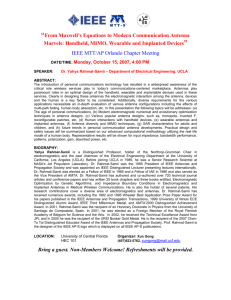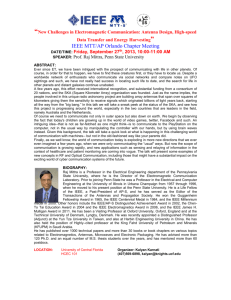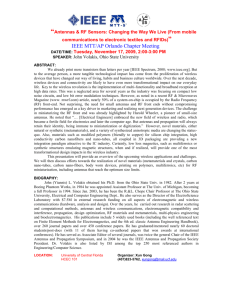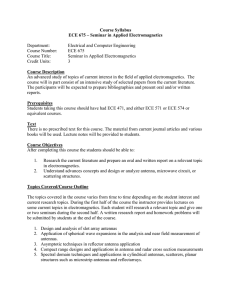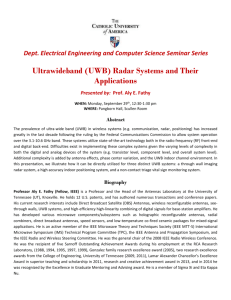Harold A. Wheeler Prize Paper Award
advertisement
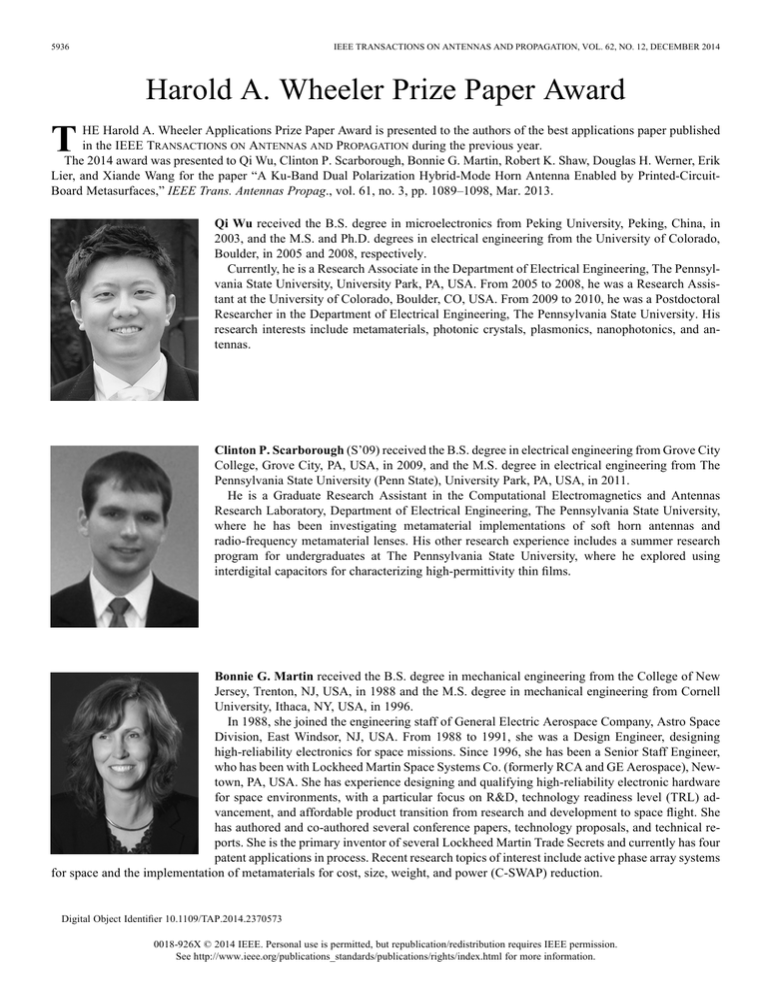
5936 IEEE TRANSACTIONS ON ANTENNAS AND PROPAGATION, VOL. 62, NO. 12, DECEMBER 2014 Harold A. Wheeler Prize Paper Award T HE Harold A. Wheeler Applications Prize Paper Award is presented to the authors of the best applications paper published in the IEEE TRANSACTIONS ON ANTENNAS AND PROPAGATION during the previous year. The 2014 award was presented to Qi Wu, Clinton P. Scarborough, Bonnie G. Martin, Robert K. Shaw, Douglas H. Werner, Erik Lier, and Xiande Wang for the paper “A Ku-Band Dual Polarization Hybrid-Mode Horn Antenna Enabled by Printed-CircuitBoard Metasurfaces,” IEEE Trans. Antennas Propag., vol. 61, no. 3, pp. 1089–1098, Mar. 2013. Qi Wu received the B.S. degree in microelectronics from Peking University, Peking, China, in 2003, and the M.S. and Ph.D. degrees in electrical engineering from the University of Colorado, Boulder, in 2005 and 2008, respectively. Currently, he is a Research Associate in the Department of Electrical Engineering, The Pennsylvania State University, University Park, PA, USA. From 2005 to 2008, he was a Research Assistant at the University of Colorado, Boulder, CO, USA. From 2009 to 2010, he was a Postdoctoral Researcher in the Department of Electrical Engineering, The Pennsylvania State University. His research interests include metamaterials, photonic crystals, plasmonics, nanophotonics, and antennas. Clinton P. Scarborough (S’09) received the B.S. degree in electrical engineering from Grove City College, Grove City, PA, USA, in 2009, and the M.S. degree in electrical engineering from The Pennsylvania State University (Penn State), University Park, PA, USA, in 2011. He is a Graduate Research Assistant in the Computational Electromagnetics and Antennas Research Laboratory, Department of Electrical Engineering, The Pennsylvania State University, where he has been investigating metamaterial implementations of soft horn antennas and radio-frequency metamaterial lenses. His other research experience includes a summer research program for undergraduates at The Pennsylvania State University, where he explored using interdigital capacitors for characterizing high-permittivity thin films. Bonnie G. Martin received the B.S. degree in mechanical engineering from the College of New Jersey, Trenton, NJ, USA, in 1988 and the M.S. degree in mechanical engineering from Cornell University, Ithaca, NY, USA, in 1996. In 1988, she joined the engineering staff of General Electric Aerospace Company, Astro Space Division, East Windsor, NJ, USA. From 1988 to 1991, she was a Design Engineer, designing high-reliability electronics for space missions. Since 1996, she has been a Senior Staff Engineer, who has been with Lockheed Martin Space Systems Co. (formerly RCA and GE Aerospace), Newtown, PA, USA. She has experience designing and qualifying high-reliability electronic hardware for space environments, with a particular focus on R&D, technology readiness level (TRL) advancement, and affordable product transition from research and development to space flight. She has authored and co-authored several conference papers, technology proposals, and technical reports. She is the primary inventor of several Lockheed Martin Trade Secrets and currently has four patent applications in process. Recent research topics of interest include active phase array systems for space and the implementation of metamaterials for cost, size, weight, and power (C-SWAP) reduction. Digital Object Identifier 10.1109/TAP.2014.2370573 0018-926X © 2014 IEEE. Personal use is permitted, but republication/redistribution requires IEEE permission. See http://www.ieee.org/publications_standards/publications/rights/index.html for more information. IEEE TRANSACTIONS ON ANTENNAS AND PROPAGATION, VOL. 62, NO. 12, DECEMBER 2014 5937 Robert K. Shaw received the B.S. and M.S. degrees in electrical engineering from The Pennsylvania State University, University Park, PA, USA, in 2005 and 2007, respectively. He was a Research Assistant at the Computational Electromagnetics and Antenna Research Lab (CEARL), The Pennsylvania State University, from 2003 to 2007. Since 2007, he has been an RF Engineer for Lockheed Martin Space Systems, Newtown, PA, USA, designing antennas and waveguide components for satellites. He has authored and coauthored 12 journal and conference papers. His areas of research have included active array antennas and metamaterials. Douglas H. Werner (F’05) received the B.S., M.S., and Ph.D. degrees in electrical engineering and the M.A. degree in mathematics from The Pennsylvania State University (Penn State), University Park, PA, USA, in 1983, 1985, 1989, and 1986, respectively. He is the John L. and Genevieve H. McCain Chair Professor in the Department of Electrical Engineering, The Pennsylvania State University. He is the Director of the Computational Electromagnetics and Antennas Research Lab as well as a member of the Communications and Space Sciences Laboratory (CSSL). He is also a faculty member of the Materials Research Institute (MRI), The Pennsylvania State University. He holds seven patents, has published more than 500 technical papers and proceedings articles, and is the author of eight book chapters with four additional chapters currently in preparation. His research interests include theoretical and computational electromagnetics with applications to antenna theory and design, phased arrays, microwave devices, wireless and personal communication systems, wearable and e-textile antennas, conformal antennas, reconfigurable antennas, frequency-selective surfaces, electromagnetic wave interactions with complex media, metamaterials, electromagnetic bandgap materials, zero and negative index materials, fractal and knot electrodynamics, tiling theory, neural networks, genetic algorithms, and particle swarm optimization. He is a former Associate Editor of Radio Science and an Editor of the IEEE Antennas and Propagation Magazine. He edited a book Frontiers in Electromagnetics (IEEE Press, 2000). He has also contributed a chapter for a book entitled Electromagnetic Optimization by Genetic Algorithms (Wiley Interscience, 1999) as well as for the book entitled Soft Computing in Communications (Springer, 2004). He has recently coauthored a new book entitled Genetic Algorithms in Electromagnetics (Wiley/IEEE, 2007). He has also contributed an invited chapter on “Fractal Antennas” for the new edition of the popular Antenna Engineering Handbook (McGraw-Hill, 2007) as well as a chapter on “Ultra-Wideband Antenna Arrays” for a book entitled Frontiers in Antennas: Next Generation Design and Engineering (McGraw-Hill, 2011). Prof. Werner is a member of the American Geophysical Union (AGU), URSI Commissions B and G, the Applied Computational Electromagnetics Society (ACES), Eta Kappa Nu, Tau Beta Pi, and Sigma Xi. He was the recipient of a College of Engineering PSES Outstanding Research Award and Outstanding Teaching Award in 2000 and 2002, respectively. He was also presented with an IEEE Central Pennsylvania Section Millennium Medal. In 2009, he received the PSES Premier Research Award. He is a Fellow of the IET (formerly IEE), and the ACES. He was presented with the 1993 Applied Computational Electromagnetics Society (ACES) Best Paper Award and was also the recipient of a 1993 International Union of Radio Science (URSI) Young Scientist Award. In 1994, he received the Pennsylvania State University Applied Research Laboratory Outstanding Publication Award. He was a coauthor (with one of his graduate students) of a paper published in the IEEE TRANSACTIONS ON ANTENNAS AND PROPAGATION, which received the 2006 R. W. P. King Award. In 2011, he received the inaugural IEEE Antennas and Propagation Society Edward E. Altshuler Prize Paper Award. He has also received several Letters of Commendation from the Pennsylvania State University Department of Electrical Engineering for outstanding teaching and research. 5938 IEEE TRANSACTIONS ON ANTENNAS AND PROPAGATION, VOL. 62, NO. 12, DECEMBER 2014 Erik Lier (F’05) received the M.S. and Ph.D. degrees in electrical engineering from the Norwegian University of Science and Technology, Trondheim, Norway, in 1976 and 1982, respectively. In 1977, he joined the faculty at the Norwegian University of Science and Technology as a Scientific Assistant and was a Research Scientist there with the Electronics Laboratory from 1978 to 1990, where he carried out national and international projects (European Space Agency/ESA, INTELSAT, INMARSAT) in the area of microwave antennas, direct broadcasting satellite (DBS) technology, digital beamforming networks, and phased-array antennas. He was a co-inventor of the concept “soft and hard EM surfaces.” In 1989, he spent one year as a Scholar with the University of California, Los Angeles. Since 1990, he has been with Lockheed Martin (LM) Commercial Space Systems (former RCA and GE Aerospace), Newtown, PA, USA, as a Principal Antenna Engineer and Technical Fellow. He has been involved in the design of various satellite antenna components and systems, and has been a technical consultant and reviewer on various satellite programs. He was instrumental in bringing shaped reflector technology to the company in 1992, resulting in winning ASIASAT-2. He lead the antenna element development that was a discriminator for winning GPS IIRM and later GPS III satellite programs. He has been involved in phased-array antenna system trades and has been leading the development of array antenna hardware as well as software for array analysis, synthesis, and calibration. In 2008, he initiated and has since been heading up the internal metamaterials research collaboration effort within LM, and is also engaged in an extensive collaboration effort with universities. He has authored and co-authored more than 100 journal and conference papers and holds 21 patents with multiple patents pending. He is currently authoring a chapter in the Reflector Antenna Handbook (Artech House) on “Soft and hard horn antennas.” His main research interest is in active phased-array antennas, and since 1993, he has been a main contributor and leader in the development of this technology within the company. Dr. Lier received the 1993 GE technical excellence award for introducing shaped reflector antenna technology to the company, and the LM Space Systems Company Publications award in 2010 Xiande Wang (M’03–SM’09) received the B.Sc. degree in radio physics from Lanzhou University, Lanzhou, China, in 1989, and the M.Eng. and Ph.D. degrees in electrical engineering from Xi’an Jiaotong University, Xi’an, China, in 1996 and 2000, respectively. Currently, he is a Research Associate with the Department of Electrical Engineering and the Material Research Science and Engineering Center (MRSEC), The Pennsylvania State University, University Park, PA, USA. From 1989 to 2001, he was an Assistant Engineer, an Engineer, and a Senior Engineer in the China Research Institute of Radiowave Propagation (CRIRP). From 2001 to 2006, he was a Research Scientist in the Temasek Laboratories, National University of Singapore. His research interests include numerical techniques and fast algorithms for computational electromagnetic metamaterials, the spatial-domain Green’s function for multilayered media, electromagnetic scattering and radiation in complex media for applications in antennas and frequency-selective surface, scattering cross-section predication for complex objects in complex environments, as well as wave propagation and scattering of random media and rough surfaces and their applications in target detection and microwave remote sensing. Dr. Wang is a Senior Member of the Chinese Institute of Electronics and a Member of the Chinese Institute of Space Science. He is a reviewer for papers in the IEEE Antennas and Propagation Magazine, IEEE TRANSACTIONS ON ANTENNAS AND PROPAGATION, Radio Science, IET Microwaves, Antennas & Propagation, and the Journal of Electromagnetic Waves and Applications.

